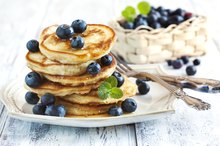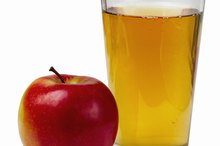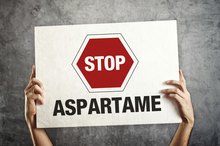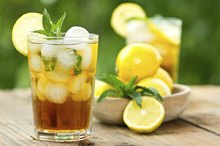Is Knox Gelatin Good for Gout?
According to the Mayo Clinic, gout occurs when you have a high level of uric acid in your system, and uric acid is produced as your body breaks down purines -- substances found in foods including organ meats, asparagus and mushrooms. Gelatin is one of many foods that are low in purines, so it is safe to eat when you are undergoing an attack of gout or want to help protect against future attacks. Gelatin can be whipped up into a low-calorie dessert, and gout is associated with people who are overweight. So if you substitute gelatin desserts for cheesecake and maintain or lose weight, the number and severity of gout attacks may decrease.
If you are experiencing serious medical symptoms, seek emergency treatment immediately.
Gout
A complex form of arthritis, gout can be extremely painful. As the Mayo Clinic explains, gout occurs when an excess amount of uric acid accumulates around a joint, usually in your feet or toes and often around your big toe. Normally, uric acid dissolves in your bloodstream and exits through the kidneys and is then excreted in urine. But when too much uric acid is produced or not enough excreted, it can build up and form needle-like crystals that can cause severe pain and inflammation.
- A complex form of arthritis, gout can be extremely painful.
- As the Mayo Clinic explains, gout occurs when an excess amount of uric acid accumulates around a joint, usually in your feet or toes and often around your big toe.
Knox Gelatin
Buttermilk & Gout
Learn More
Knox gelatin was created in 1890 by Charles Knox, who came up with an easier way to make the granulated product. Due to its ease of use, and Knox's advertising prowess -- he became known as the "Napoleon of Advertising" -- Knox gelatin, and gelatin desserts such as Jell-O, became household staples. Knox remains the leading brand of gelatin in America, as of publication, and it also is used as a remedy for arthritis by many people. The research into gelatin for arthritis has yielded mixed results, and there is no evidence to date that gelatin itself can prevent gout.
- Knox gelatin was created in 1890 by Charles Knox, who came up with an easier way to make the granulated product.
- The research into gelatin for arthritis has yielded mixed results, and there is no evidence to date that gelatin itself can prevent gout.
Purine Foods
If you have gout or want to avoid future attacks, cutting down on foods with high levels of purines might make a difference. Foods to avoid include alcohol, organ and game meats, gravies, sardines and scallops. Foods moderately high in purines, which should be eaten in moderation, include:
- fish
- meat
- poultry
- whole grains
- cereals
- eggs
Considerations
Foods That May Cause Joint Pain
Learn More
Gout is associated with obesity and with conditions associated with obesity, such as high blood pressure, high cholesterol and diabetes. So using gelatin to replace high-calorie desserts, along with a healthy diet, might reduce the chances of gout 1. There are other foods that might relieve gout, including strawberries, salmon, flaxseed and olive oil. The Mayo Clinic notes that coffee, vitamin C and cherries reduce uric acid levels, but further research is needed to determine their precise relationship in treating or preventing gout.
- Gout is associated with obesity and with conditions associated with obesity, such as high blood pressure, high cholesterol and diabetes.
- The Mayo Clinic notes that coffee, vitamin C and cherries reduce uric acid levels, but further research is needed to determine their precise relationship in treating or preventing gout.
Related Articles
References
- Every Diet: Gout Diet
- National Institute of Arthritis and Musculoskeletal and Skin Diseases. Gout. Updated April 2016.
- Zhang Y, Chen C, Choi H, et al. Purine-rich foods intake and recurrent gout attacks. Ann Rheum Dis. 2012; 71(9):1448-53. doi:10.1136/annrheumdis-2011-201215
- Fischer E. Ueber die Harnsauer. 1 [On Uric Acid. 1]. Berichte der Deutschen Chemischen Gesellschaft. 1884: 17:328-338. doi:10.1002/cber.18980310304
- Ragab, G., Elshahaly, M., & Bardin, T. (2017). Gout: An old disease in new perspective – A review. Journal of Advanced Research, 8(5), 495–511. doi:10.1016/j.jare.2017.04.008
- Centers for Disease Control and Prevention. Gout. Updated January 28, 2019.
- Zgaga, L., Theodoratou, E., Kyle, J., Farrington, S. M., Agakov, F., Tenesa, A., … Campbell, H. (2012). The Association of Dietary Intake of Purine-Rich Vegetables, Sugar-Sweetened Beverages and Dairy with Plasma Urate, in a Cross-Sectional Study. PLoS ONE, 7(6), e38123. doi:10.1371/journal.pone.0038123
- Choi HK, Gao X, Curhan G. Vitamin C intake and the risk of gout in men: a prospective study. Arch Intern Med. 2009;169(5):502–507. doi:10.1001/archinternmed.2008.606
- Zhang Y, Neogi T, Chen C, Chaisson C, Hunter DJ, Choi HK. Cherry consumption and decreased risk of recurrent gout attacks. Arthritis Rheum. 2012;64(12):4004–4011. doi:10.1002/art.34677
- Arthritis Foundation. Gout Diet: Dos and Don’ts.
- Boban M, Modun D. Uric acid and antioxidant effects of wine. Croat Med J. 2010;51(1):16–22. doi:10.3325/cmj.2010.51.16
- Caliceti C, Calabria D, Roda A, Cicero AFG. Fructose Intake, Serum Uric Acid, and Cardiometabolic Disorders: A Critical Review. Nutrients. 2017;9(4):395. Published 2017 Apr 18. doi:10.3390/nu9040395
- U.S. Department of Health and Human Services and U.S. Department of Agriculture. 2015–2020 Dietary Guidelines for Americans. 8th Edition. Published December 2015.
- U.S. Department of Health and Human Services. Gripped by Gout. NIH News in Health. Published February 2014.
- Kakutani-Hatayama M, Kadoya M, Okazaki H, et al. Nonpharmacological Management of Gout and Hyperuricemia: Hints for Better Lifestyle. Am J Lifestyle Med. 2015;11(4):321–329. Published 2015 Sep 2. doi:10.1177/1559827615601973
Writer Bio
Jim Thomas has been a freelance writer since 1978. He wrote a book about professional golfers and has written magazine articles about sports, politics, legal issues, travel and business for national and Northwest publications. He received a Juris Doctor from Duke Law School and a Bachelor of Science in political science from Whitman College.









